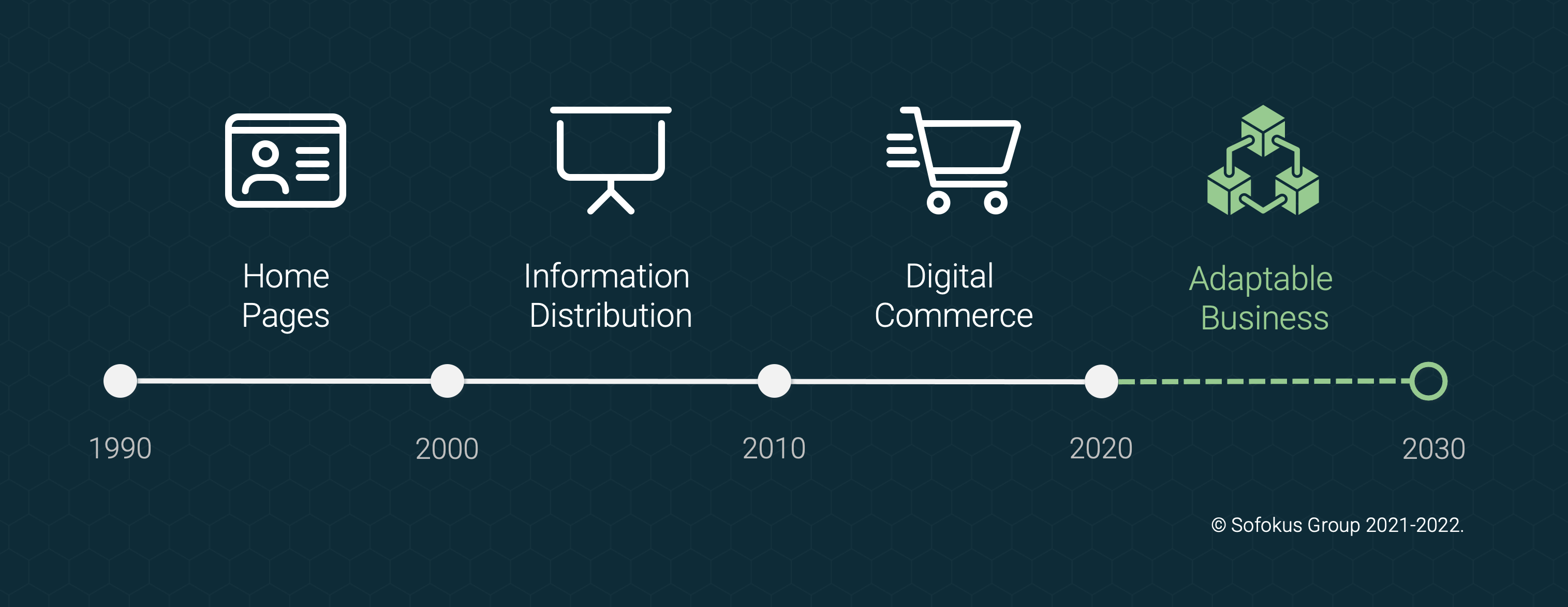
Digital business
GUIDE: a regularly updated information package for digitalizing business
Updated August 5.8.2022
What is digital business?
Digital Business is a process where digital technologies are for innovation of new business models, resulting in a better customer experience for the company’s products and services.
Utilizing digital business blurs the boundaries between the digital and physical worlds.
Digital business, therefore, does not only mean operations based purely on software but describes the journey by which the digital maturity level of the company’s business is raised. Thus, any traditional company can start the journey towards a more digital business.
Nobody starts a new business wondering if sales or marketing is needed – they are taken for granted. Digitalization should also be considered as an ordinary means of business development. It removes the mystique around digital and makes practical things easier. For example, digital development can be budgeted annually, just like marketing.
This online guide is split into chapters explaining what digital business means and how it can be utilized in an organization’s operations. In addition to the most common application methods, the guide lists the latest future-oriented frameworks and trends.
The aim of this guide is to provide the market’s most comprehensive, relevant and up-to-date understanding of digital business development for businesses.
Why is digital business useful?
Researches show that digital makes business more profitable. A Deloitte study found that companies that implemented seven digital solutions on a large scale managed better financially than their competitors. These digital solutions included, for example, the utilization of ecosystems, developing a holistic customer experience, and adaptable business. The turnover of companies with a high level of digital maturity also grew faster and their operations were more profitable.
Although the business benefits of digitalization are easy to verify, there are many companies that don’t want to invest in innovation or pioneering in the form of digital development. Investments are made more moderately, and development is practical. Even ten years ago, in many industries, it was enough if you had a simple website where you could find basic information about your operations. Today, the pressure to develop digital business comes from customers.
This pressure from customers directs companies to do digital development closer to their core business: a chatbot alongside telephone support, a digital self-service interface alongside brick-and-mortar commerce, an online store alongside mail order, and so on. And when enough companies in the industry (sometimes even one is enough) switch to offering digitalized services, knowledgeable customers begin to demand them from others as well.
Working methods have gone through a revolution further accelerated by the pandemic. When physical interaction was not possible, remote communication had to be developed. New organizational models – such as self-directedness – have also raised the need to introduce new modern work tools that transparently extend communication to the entire organization.
Digital business and its development will soon become a matter of course. The good news is that, along the way, tools, systems, and working methods have developed so much that today it is possible to get even fully tailored solutions at a moderate price. In addition, there are plenty of excellent and budget-friendly cloud services on the market with which you can digitalize your operations. So it’s worth getting to know what’s new on the market or asking experts.
The history of digital business
In a nutshell, digital business has developed as illustrated in the following picture at the level of decades.

In the 1990s, digitality was associated with static web pages (or so-called home pages). In fact, business didn’t have much to do with digital at that time. The home page was seen more as a virtual showcase of a company’s offering or as a business card in electronic form.
In the early 2000s, various dynamic information sharing services, picture banks, and the like expanded the general image of digitality a little closer to business: important stakeholders could be provided with essential information via extranets and intranets. For example, customer-specific price lists and almost real-time visibility into inventory balances were made digital.
In the 2010s, the general image of online shopping started to turn in a positive direction. Buying online was no longer hindered by people being scared of entering their credit card information on the internet. The explosive rise of online stores began. Nowadays, you can buy almost everything you can imagine online.
Right now, in the 2020s, we are living in the age of adaptable business. This era has brought two new requirements for companies that make extensive use of digitality:
- Deep digitalization of core business. The degree of digital maturity should be so high that it extends to the core business systems and enables full-scale digital transactions with the company.
- The ability to micro-pivot. Micro-pivoting means continuous small and quick business direction corrections in accordance with the needs and opportunities created by customer demand and trends while staying in line with vision and strategy.
The good news for those digitalizing their operations is that the solution models typical for each decade are still usable, and each can generate measurable business value. In the following paragraphs, I will describe in more detail how the different possibilities of digitalization can be identified and implemented, and how to choose methods that suit the goals and resources of your business.
What is the difference between business digitalization and digitization?
Digitalization refers to the renewal of existing business models. Estonia’s e-residency program is an example of how starting a company has been completely reinvented. Through the service, one can establish a company in Estonia from anywhere in the world.
The reforms that take place at the fundamental level and bring about radical change are called disruptive. Familiar examples of disruptive digital innovations are Uber, Wolt ,and Airbnb.
In reality, disruptive innovations get way too much attention because digitalising operations usually looks and feels like straightforward, modern business development. That’s why this guide will focus more on digital business examples accessible to everyone without Silicon Valley-level funding rounds.
Do you remember when you still used coins for parking fees? Parking payment applications and other payment methods have rapidly replaced cash as a means of payment. Instead of just converting a physical payment instrument into an electronic one, the parking payment application also enables location-independent payment, extending the payment period remotely, text reminders, and much more. Digitalization is simply modernizing the old to be more customer-oriented.
An indication of successful digitalization is renewing the operating model in a way that people don’t want to return to the old one.
Digitization of business means a more straightforward utilization of digitality. The business information system YTJ is about transferring paper forms to electronic ones. It is convenient to be able to start a company electronically these days, but in reality, it is only possible in a few cases and usually needs to be done traditionally.
Estonia’s e-residency and Finland’s YTJ are examples of how a similar need (establishing a company) can be electrified in many different ways. You can approach the renewal of your operations thoroughly (digitalization) or move the physical processes and habits more mechanically to an electronic form (digitization).
It is important to note that there is a time and place for both ways. The digitalization of operations is more multi-phased: it almost always requires redesigning the business, then designing services, and finally implementing them. In addition, the result is significantly affected by the level of ambition and the success of the initial innovation and design phase. However, digitization is usually more far-reaching because it seeks changes at the levels of the business concept and core earning models.
Digitization is more straightforward, where, for example, paper forms are transferred to an electronic system. Simply offering an electronic version of a manual task is usually a big deal for your customers. In addition to a phone call, the customer can contact you via a chatbot or check the status of their order in the mobile application whenever they wish. Straightforward electrification of operations should therefore not be underestimated – on the contrary, it usually leads to setting more ambitious goals in the future.
Digital business can be seen as a journey where the degree of digitality varies.
With this way of thinking, things that seem detached fall logically into place:
- Digitization. The beginning of the journey. Cautious, but purposeful experimentation. Transferring physical processes as such to digital ones.
- Digitalization. Acceleration phase. Business rethinking and bold innovation.
- Disruption. Full speed. The goal is to provoke paradigm-level change. All-or-nothing-thinking steps in the game.
Digital business is a journey that should be tailored to each company’s target level, budget, and capabilities.

Case: Digitalizing the cleaning industry
Regardless of industry, customers demand new ways to buy and use company services. It’s a sweet spot for digital business. Read a case example about digitalizing the cleaning business.
Figure out the current state and define the target level
When talking about digital business development, the mind easily strays too much toward technology. As the name suggests, it is primarily about business. Digitality comes into play to the extent of how thoroughly electrified business is being built.
When doing business development, you must be able to assess the current state and reflect it realistically on the competitive field. It is essential to set a target level, paint a vision of the future, and set milestones to assess whether you are going in the desired direction. This is a standard and functional basic principle of business development, regardless of the degree of digitalization.
There are numerous ways to consider the degree of digitalization, one of them being the concept of digital maturity level. The idea is to identify the starting situation of your company and define the target level regarding the utilization of digitality. The model can also be used to compare your and competitors’ digital maturity levels. According to a Deloitte study, the profit margin of digitally mature organizations was 28 percentage points better than those with low maturity.
When modeling the digital maturity level, the most important thing is to get a clear understanding of your starting situation and its relation to the market situation. Digitality is only one element on the way to a better business. With Sofokus’ digital business maturity model below, you can do a quick evaluation of the starting situation of your operations and consider your target level.

Refuser
No need or desire for digitalization.

Rookie
Digital development is random.

Intermediate
Continuous digital development and monitoring of some operations.

Advanced
Continuous digital development and monitoring of core operations.

Transformer
Customer-driven development, pursuit of competitive advantages.

Pioneer
Industry-reforming, ecosystem-driven.
Digital maturity level 0: Refuser
Sometimes there is absolutely no business need for digitalization. For example, an individual’s investment company may function well without social media and websites. Of course, it can be the case that digitality still plays an important role in the background, for example through the social media presence of a personal brand.
Digital maturity level 1: Rookie
Rookies might feel disbelief towards digital technology. This often manifests in making mostly one-time purchasing decisions based mainly on price. A rookie may be inspired by finding someone who can concretely prove the business value that can be obtained from digital (for example, more leads or sales).
Digital maturity level 2: Intermediate
An intermediate believes in digital technology and actively utilizes it. Maintaining a digital presence is self-evident (for example, having functioning websites). However, efficient value generation of digitality is still experimental.
Digital maturity level 3: Advanced
Advanced players have a pragmatic approach to digital: it means functional IT acquisitions and a practical purchasing culture. Digitality is already widely used, websites have typically turned into online shops, and the added value created by digitalization affects the entire company. The main focus is on tried-and-tested off-the-shelf solutions. An advanced player is not necessarily looking for a competitive advantage but aims to enhance existing operations practically.
Digital maturity level 4: Transformer
Transformers embrace a modern organizational culture of experimentation and customer-oriented thinking and it is ready to challenge their business models. The pursuit of competitive advantage through digitalization typically boils down to the development of an own digital core system.
Digital maturity level 5: Pioneer
A pioneer invests all they have to innovate something that will revolutionize the world. The company’s growth rate and ability to disrupt the market are such that the company may be listed on the CNBC Disrupt-50. Not many pioneers can fit into one industry at a time.
A higher level of maturity does not automatically mean better business performance but refers to the degree of utilization of digitality in operations. Still, it is good to note that several different studies show how a heavy digital investment correlates with successful business performance.
What areas of business can or should digitalization extend to?
At the beginning of the millennium, it was avidly discussed where digitality suits and where not. Nowadays, the discussion is more academic, because time and time again someone succeeds in digitalizing an area that previously seemed impossible. It is more relevant to consider which area would be most natural to start with, what it would require, and whether the company’s resources are sufficient.
One of the ways to guide digital development is simple: annual budgeting. How much can the company invest annually in development? It doesn’t matter whether it’s human resources, external purchasing services, or software acquisitions, budgeting sets concrete limits. For example, when it comes to opening an online store, it is unrealistic to seek market leadership if the budget is not sized for sufficient measures. On the other hand, lightly testing the demand in the market can be an inexpensive procedure if using ready-made cloud online stores.
Measure your resources realistically concerning your expected results.
Another practical way is to evaluate your operations through business areas. Examining the following sub-areas can give important insights into the development of a suitable digitalization strategy.
- Customer. In customer-oriented development, the customer is the starting point. Boardman’s Customer Economy publication gives perspectives on the promotion of customer-driven development.
- Strategy. Focusing on the strategy and earning model guides the improvement of the core business concept. This is one perspective for developing your own digital heart increasing competitive advantage. An external sparring partner is a handy help when you want to rethink things thoroughly.
- Organizational culture. Objectively evaluating your organizational model and culture give direct indications, for example, to what level of digital maturity you should aim for. For example, a naturally transparent, low-hierarchical, and continuously learning organizational culture is excellent for quick market experiments. Explore the models of the world’s leading companies (like Netflix and Spotify) with Sofokus’ Better Monday podcast.
- Value networks. Are your operations partner-driven? Could you make use of ecosystems in your business, for example, by adopting platform economy earning models?
- Technologies. Does your organization rely on modern cloud services? Do you currently rely on a traditional enterprise resource planning system? Have you started or are you planning on developing your own competitiveness-creating Digital Heart? Observing the use of technologies in your organization gives good hints on how technical development should be directed.
It is worth approaching the issue through your strengths. In which of the aforementioned areas is your company already good at? Digitalizing an already strong area can be easier than strengthening a completely new one.
Composable commerce and digital business
Digital business has long been associated with e-commerce. Although B2C e-commerce is a popular way to digitalize the physical offering, it is a rather narrow view of digital business. As I presented at the beginning of the history chapter, we are living in an era of adaptable business, where customers already expect companies to digitalize their operations.
Implementing an off-the-shelf cloud-based online store does therefore not equal a full-scale digitalization of operations. Starting a traditional web shop raises the maturity of the company to either level two or three. Things get easier to understand when you break e-commerce down into smaller business components.
The following is a summary of the core business-supporting functions offered by a typical online store:
- Product views. The possibility to browse the product offering in list or matrix format, for instance.
- Search function. The possibility to find the desired product based on a keyword.
- Shopping basket. Possibility to move the desired product to the shopping cart for purchase.
- Payment methods. The possibility to pay for the purchased product with the desired payment method.
- Delivery methods. The possibility to choose how the product is delivered.
- Status monitoring. The possibility to monitor the order/delivery process as real-time as possible.
Although the list described above is somewhat simplified, it broadens the understanding that a typical online store is just a set of a few simple key functions connected to your business.
Instead of thinking of “opening an online store”, focus on considering what core functions your digital business should include.
In the summer of 2020, Gartner came up with a name for this way of viewing e-commerce as a set of business components: composable commerce. Essentially, a composable online store looks the same to the customer as any other online store, but it is thought out and implemented in a fundamentally different way.
Composable commerce is about finding, conceptualizing, and implementing operations that best work for each online store. In other words, exactly what different e-commerce software providers have been trying to offer for years, but in a more defined format. This does not mean that there is something wrong with ready-made e-commerce engines, but that the options for e-commerce can be sorted into different maturity levels just like any other area of digital business: a cloud-based store is suitable for quickly testing the market, a composable store for deep digitalization, and so on.
One special case of e-commerce is ticket sales systems. In these online stores, the main selling item is access to an event. Ticketing systems often involve a lot of special needs, such as physical self-service ticket booths, cash register integrations, or the use of RFID technologies.
Digital Marketing and digital business
As it has become clear from the previous paragraphs, digital business is a holistic way of approaching the modernization of business operations. Digital marketing is one of the perspectives that seem to make sense more easily to people than, for example, the competitive advantage created through Digital Heart software development.
Digital marketing is a broad area of business development, but it can be summed up in the concept of digital footprint. Digital footprint means how widely, easily, and often a company’s brand, products, and services are visible to others online.
The battle between Amazon and Google for the visibility of their digital footprint is an extreme example. Although Google has become almost synonymous with web searches on a global level, 54% of product-based searches (in the United States) were directed to Amazon in 2018. In practice, this means that while Google is still the most popular general search engine, Americans are looking for products on Amazon.
Digital marketing is basically about building a digital footprint as large as possible. As a result, the company can, for example, open a dialogue with potential new customers or increase online store sales. Although digital marketing is constantly developing, its basics have remained quite similar.
One of the most celebrated books about growth hacking, Traction, was published in 2014. It summed up well the types of digital marketing methods that can be used: PR, SEO, SEM, viral marketing, digital advertising, social media, content marketing, email marketing, and community and affiliate programs. The Bullseye method presented in the book is still a practical and easy tool for learning how to apply digital marketing in your business.
An evergreen guideline for digital marketing is to produce better content than others in your field and to expand its spread with up-to-date means.
Although all the aforementioned methods can still be used in digital marketing, you need to understand their starting levels of effectiveness and how to apply them properly. Let’s look at a couple of clarifying examples:
- Content marketing. In the early 2000s, it was enough to open a blog and occasionally post content on a topic. More visibility could be gained with questionable SEO rigging. In the 2020s, the content quality must be better and more comprehensive than others if you want to make it to the top search results. Essentially, visibility improves only by making better content aimed at people, not computers.
- Email marketing. In the early 2000s, it was enough to collect a comprehensive list of e-mail addresses and use it for product promotions with a simple spamming tactic. In the 2020s, it is essential to deliver engaging content. Then the recipient must actively indicate that they are interested in receiving similar content in the future. After that, you have to actively create more content, share it in moderate doses, and provide value for the recipient.
The comforting news is that at any moment there is an innumerable set of effective methods and tools that can positively influence the company’s digital visibility. However, simply copying from your neighbor will not get you very far. You should focus on high-quality content with which your products and services will raise interest in your target group.
Culture, people, and digital business
People and culture are the most important – and at the same time possibly the most difficult – areas to be developed in digital business. The entire development curve of digital business is an example of the effects of culture and attitudes. Amazon, Google, and Verkkokauppa.com each started their operations already in the 90s. The said companies are ahead of others simply because they have, for almost 30 years, consistently and without prejudice digitalized things that others have not dared to.
All the most important innovations: websites, search engines, online stores, and so on were already invented at the beginning of the internet age, but their normalization in people’s minds has taken time. The most important aspect of digital business can be considered to be influencing culture and people’s attitudes and thoughts.
From the viewpoint of business development, the impact of digitality can be seen as two-way:
- The direction of influence: from company to people. Pioneering companies strive to shape people’s attitudes by concretely demonstrating what it is possible to do by applying digitalization without prejudice. When an early adopter sees and experiences, they believe. The influencing work continues to reach the tipping point launched by Gladwell, and the phenomenon in question becomes adopted by the great public.
- The direction of influence: from people to companies. The more natural direction of digital influence comes from people to companies. Customer-centered thinking can be seen as a counterstrike to the fact that customers have voted with their feet for more modern services. Would you still agree to open an account with a bank that does not offer online account management at all? Customers often tell what and how the company should digitalize.
Consider which direction of influence is more natural for your company.
In addition to the direction of influence, you can consider whether to direct your development efforts to internal or external stakeholders:
- Internal stakeholders. An internal stakeholder is the company’s staff or one of its departments like marketing or sales. In what ways could digitality affect sales, e.g. with the help of automation, data utilization, or artificial intelligence? Developing a more innovation-driven company could promote the creation of a culture of experimentation.
- External stakeholders. The most typical external stakeholders are customers and partners. Are you providing your customers with a new digital self-service channel, with which they can take control of things with you? Do you offer partners extranet-style access to relevant information?
Regardless of the chosen viewpoint, digital development requires motivation and interest. Bad software can be recognized by the fact that nobody wants to use it. The number of functionalities does not produce a better digital service, the user experience, usefulness, and sense of security do. In the next paragraph, we’ll dig deeper into the consideration of the stakeholders on a larger scale.
Platform economy, ecosystems, and network effects
A company aiming for the highest level of digital maturity invests in ecosystems and the earning models it enables. The goal of ecosystem-driven business logic and earning models (such as platform economy) is to build networks that cross traditional industry boundaries and generate network effects.
If the previous song was difficult to grasp, I’m not surprised. So far, not that many companies have focused on developing ecosystems, platform economy, or network effects. One of the reasons for the lack of their utilization is that the aforementioned concepts change the commonly known way of doing work, transforming networks and operations to digital. Secondly, value network thinking can create network effects that cause disruption, and creating it is challenging to say the least. Airbnb, Amazon, and Uber are classic examples of the power of digital platforms in shaping entire industries.
Due to its disruptive qualities, it is natural that only pioneering companies seek out the platform economy and network effects.
A much more interesting question is, do these give anything to ordinary companies that don’t have a Silicon Valley-level budget to spend or market disruption in mind?
The answer is yes.
It’s about choice, and this conclusion is easier to understand by breaking it down into a few different strategy paths and looking at the matter from the perspective of hotel reservations.
1. The hotel does not develop its reservation service but uses existing platforms
The easiest and fastest way to digitalize your operations is to use ready-made solutions and platforms. It is simpler for a new hotel to start using booking.com instead of creating its own reservation service. Most companies choose this type of option (digital maturity levels 1–3).
Ready-made platforms typically include all social media platforms (Facebook, Instagram, LinkedIn), video platforms (Youtube, Vimeo), e-commerce platforms (Amazon, Alibaba), and so on. The implementation of ready-made platforms is fast but requires investment in a good and distinctive business concept because the competition for visibility on ready-made platforms is fierce. A new hotel entrepreneur will inevitably have to compete with other accommodation companies in the same area on the booking.com platform.
2. The hotel builds its own reservation service but does not offer it to others as a platform
The new hotel reckons that it makes the most sense to build its own reservation service to maximize profit margins. Booking.com’s booking commission is so high that building its own booking system pays for itself in the end. The hotel decides to join booking.com as well to still earn lower-margin sales as well. The hotel uses a lot of resources to offer unique benefits to customers who book through their own service.
It doesn’t matter whether the company’s motive is to improve the digital experience of its customers, automate its processes, or utilize its existing data, this usually leads to the bottling of competitive advantages into a Digital Heart. You can keep your digital software for your own use, and as it improves, it creates a unique customer experience and stands out from the competitors. For example, when a company expands into a hotel chain, its tailored digital core software is one of the effective ways to standardize customer experience and maintain quality at different locations.
3. The hotel builds a reservation system, which it offers as a platform for anyone to use
The new hotel’s strategy is to build a reservation system that anyone can use. A booking platform is born, where the hotel competes for customers with others. The business goal changes from maximizing the occupancy rates of own hotels to attracting competitors and potential customers to the platform.
Becoming a platform is a business choice and requires adopting a new kind of worldview. For example, for competitors, sales can be one of the most important challenges that must be successfully solved. On the other hand, it can be the key to significantly faster growth and a more central positioning in the market.
Utilizing ecosystems and the platform economy can be something in business that seems to be available only for large players. In reality, it’s a model that might perfectly fit the goals and activities of a smaller business as well.

Case: Platform economy as a business model
Did you know that you can become ecosystem-driven at a later stage of your business journey as well?
SYKE Tribe is the most popular digital coaching platform in Finland. It connects coaches and trainers in the sports and wellness industry and also offers business and lifestyle coaches a place to share their expertise.
An adaptable Digital Heart
The Digital Heart stands for a system that supports (or enables) your core business. Without it, business operations would cease or at least be hindered. The Digital Heart can be a singular system adapted to your core business but is more typically an entity built from several interconnected software.
The Digital Heart is essential an essential concept for building digital business for two reasons:
- It improves the company’s competitiveness
- It enables a high digital maturity level
The digital heart is actually one of the best tangible catalysts for a company to pursue more ambitious goals. Summarized, the development path often goes like this:
- Evaluating the current business and thinking about how it could be shaped more attractively than the competitors’
- Planning, executing and launching a mock version (so-called Minimum Viable Product) of the Digital Heart that implements the concept
- Constantly improving the implementation by developing it to meet customer needs as well as possible
Building a Digital Heart is one of the best ways to start a digital transformation.
Although software (the Digital Heart) is central to digital transformation, a change in mindset is even more important. Digital development should be one of the key drivers of business development. Conceptualizing, implementing, and developing one’s own Digital Heart is therefore really an exploration into the core of one’s business. If implemented correctly, in the long term it will inevitably improve competitiveness, increase customer satisfaction and increase the value of the company.
The Digital Heart is a company-specific customized system entity and can be implemented with several different models. One is to implement a monolithic Digital Heart, where all functionalities are centralized in a single core system. Another is to connect several different software in such a way that it forms one complete business-supporting entity. If the solution built by using the latter model is based on communication between modern API interfaces and the packaging of business operations, an Adaptable Digital Heart solution is achieved, which can be more flexibly modified according to customer needs.


Do you need help?
We specialize in digital business development and offer services throughout your entire business life cycle. Shall we start with developing your business concept, implementing your online service idea, or reviewing how your current services and their data security can be further developed? Whatever your needs are related to digital business, you can contact us.
Otto Sunnari
Clients & Partners
otto.sunnari@sofokus.com
+358 44 7992908
Hannu Puras
Clients & Key Accounts
hannu.puras@sofokus.com
+358 44 312 0062
Turo Numminen
Startup Investments
turo.numminen@sofokus.com
+358 50 517 1752
Shortcuts
- What is digital business?
- Why is digital business useful?
- The history of digital business
- What is the difference between business digitalization and digitization?
- Case: Digitalizing the cleaning industry
- Figure out the current state and define the target level
- Digital maturity level 0: Refuser
- Digital maturity level 1: Rookie
- Digital maturity level 2: Intermediate
- Digital maturity level 3: Advanced
- Digital maturity level 4: Transformer
- Digital maturity level 5: Pioneer
- What areas of business can or should digitalization extend to?
- Composable commerce and digital business
- Digital Marketing and digital business
- Culture, people, and digital business
- Platform economy, ecosystems, and network effects
- 1. The hotel does not develop its reservation service but uses existing platforms
- 2. The hotel builds its own reservation service but does not offer it to others as a platform
- 3. The hotel builds a reservation system, which it offers as a platform for anyone to use
- Case: Platform economy as a business model
- An adaptable Digital Heart

